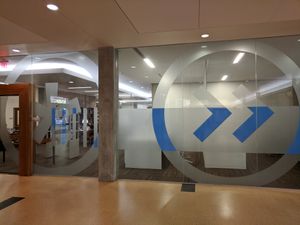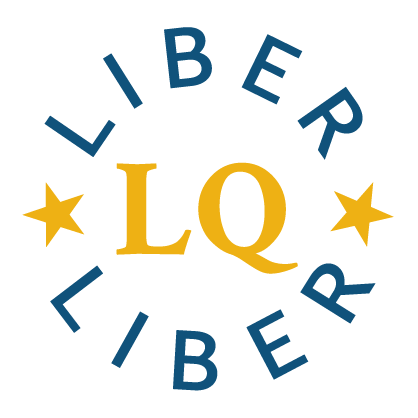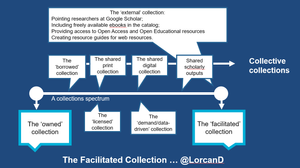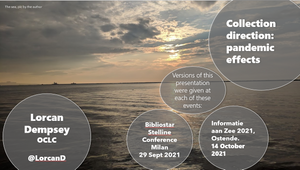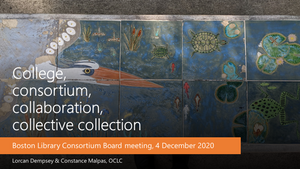UC and Elsevier
A tremor was felt in The Force on February 28 2019 as the University of California announced that it had terminated its contract with Elsevier. This was widely seen as a landmark event in the ongoing contest over the future of scholarly communication.
In part this is because of the scale of the University of California: the press release notes that the University of California accounts for 10% of research outputs in the US. In aggregate it represents an extraordinary richness of teaching, research and service capacities, across major universities, health facilities, research labs, and an array of associated organizations.
It is also interesting that the UC is structured in a way that this scale can be leveraged. A critical element of the UC’s position is the administrative and academic buy-in it has achieved across the organization for this step, the latter facilitated by a systemwide academic senate. It also has capacity for collective action through the UC Office of the President which focuses its efforts “where we think a systemwide perspective adds the most value.” This is the organizational home of the California Digital Library, which leverages the scale of UC in negotiating and managing licensed resources.
Of course, this makes CDL and UC different from other major research university (and library) groupings – Ivy Plus or BTAA, for example – which gather independent institutions, and which don’t readily have the same level of shared capacity and organizational alignment.
The announcement generated several strands of conversation and comment. MacKenzie Smith, UC Davis University Librarian and Vice Provost, saw it “as a harbinger of a tectonic shift in how universities and their faculty share research, build reputations and preserve knowledge in the digital age.” Judy Ruttenberg applauded the UC commitment to support faculty publishing charges in the transition from a pay to read to a pay to publish model. While it was seen as a significant event for open access, it is also important in the context of the big deal which has so characterized library licensing of journal material in recent years. Collection development AULs Kosokoff and Brundy noted that “We are not aware of any academic institution that does not have renegotiation of big deals in its plans” and Roger Schonfeld suggested that the value of the big deal is in decline and argues that a major factor here is the weakened pricing power of publishers. Statements of support appeared from other libraries and library organizations. For example, Betsy Wilson, Vice Provost for Digital Initiatives and Dean of University Libraries at the University of Washington, wrote with colleagues that “The negotiations between UC and Elsevier are part of an accelerating, worldwide movement to transform scholarly communication, to ensure knowledge is shared broadly and without barriers, and to further enhance inquiry and discovery.”
However, as momentous as this event was for discussion about open access and the big deal, I want to focus here on another element of the announcement and how it intersects with some collection trends I have been talking about over the last few years. This is the guidance that the UC provides to its community for alternative access to content published in Elsevier journals (what they interestingly call “Elsevier articles”). It underlines that the classic local collecting model is changing, and that a range of different services around collections are emerging. Collections are a service alongside others. In particular, it highlights the move to what I have called the facilitated collection.
Collection directions
At the core of library collections has been the bought print collections and more recently the licensed electronic collection. Together, we might call these the ‘acquired collection’, locally managed and immediately available. Increasingly, we are seeing that the centrality of the acquired collection to the library service and identity is an artifact of particular phases of library development.
While the acquired collection is certainly still preponderantly important (just look at library budgets), I have suggested three ways in which the network has changed how we think about collections and their boundaries. The type of attention we give collections changes as libraries think more about institutional outputs (research data, preprints, ..), as researchers and learners inhabit a rich network of scholarly and cultural resources, tools and services, and as reduced interaction costs in a network environment mean that libraries collaborate more readily.
Of course, there are other ways in which the collections environment is changing but in the last few years I have found some resonance for these three ways of talking about change, and have characterized them as follows:
| Environmental trend | Library response |
| Reconfiguration of research work by the network/digital environment. | The inside-out library. |
| Research is collaborative, facilitated by automated workflows (laboratory information systems, scientific workflow systems, lab notebooks, citation management, scholarly networking sites, …) and generates a variety of potentially sharable research artifacts (software, research data, preprints/articles, textual corpora, workflows, ..). | Support researcher workflow and the creation, stewardship and disclosure of institutional research outputs (research data, preprints, expertise profiles, …) with advice, expertise and services. Make special collections and archives more accessible to researchers. |
| Reconfiguration of the information space by the network/digital environment. | The facilitated collection. |
| Researchers and learners inhabit a network environment rich in information resources – for research, for communication, for archiving, for social sharing, and so on. These are general purpose (github, WikiPedia) or specialized (Amazon, arXiv, Figshare, Google Scholar, etc). ‘Localness’ is no longer a determining influence in information use. And, in fact, the network encourages the opposite trend—towards network level concentration and specialization. The acquired library collection is one resource among many of potential interest. | In this context, we see a progressive shift from the locally acquired just-in-case collection to the collection as a service, facilitating access by researchers to resources of potential interest wherever they are. We see this also in evolution from subject to liaison, and in the progressive broadening of the ‘literacy’ role - from bibliographic instruction, to digital literacies, to broad consultation around the complexities of the emerging information environment. The latter encompasses thinking about relevant resources, researcher reputation, copyright, publishing choices and OA, data consultancy, and advice around surveillance, algorithmic retrieval, and #fake in a complex evolving environment. Arrange for a coordinated mix of local, external and collaborative resources responding to varied user needs. This activity peels away from the locally managed collection and grows to include advice and consultancy about creation and information practices in complex environment. |
| Reconfiguration of library collaboration by network/digital environment. | The collective collection. |
| The network reduces the interaction costs of collaboration, facilitating more shared and collaborative approaches. | Increasingly organize collections at the network or systemwide level (shared print, digital aggregations, …). |
I am particularly interested in the facilitated collection and to to some extent the inside-out collection here. I discuss these collection directions more fully elsewhere.

The UC announcement highlights this refocusing of attention, even if Elsevier does come back to the table.
Collections as a service: the UC guidance
So, what does the UC say about access to articles? The UC advice clusters in four areas:
- Install browser plug-ins. The OA Button and Unpaywall are noted; Kopernio could also be mentioned. Discovery service providers are also adding metadata about OA resources from these or other providers - 1Science, for example, recently acquired by Elsevier. WorldCat Discovery has a program of including metadata from various OA resources as well as links from Unpaywall.
- Search for open access copies. The guidance points to various preprint archives (eScholarship at UC, arXiv, bioRxiv, PsyArXiv, …) and, as further evidence of its centrality, notes that Google Scholar should enable the discovery of preprints through those archives. Interestingly, there is an explicit note here that the University Libraries do not endorse the use of Sci-Hub for access to articles.
- Get it from the Library. The library participates in various resource sharing networks for supply of articles, or can facilitate spot article purchase, and so on. The UC integrates Reprints Desk (also integrated with OCLC’s ILL management system, Tipasa) for single article access.
- Use your network. The guidance suggests contacting an author directly, or through scholarly networking sites (ResearchGate, Mendeley, …), or by making a request on Twitter with the #icanhazpdf This is an evolving area, but it is interesting to note how for some researchers there is a blurred boundary between scholarly identity, workflow and content, as they disclose work outputs in various profiling and scholarly networking services. Of course this underlines issues around rights in preprints and the occasionally contested relationship between such sites and publishers.
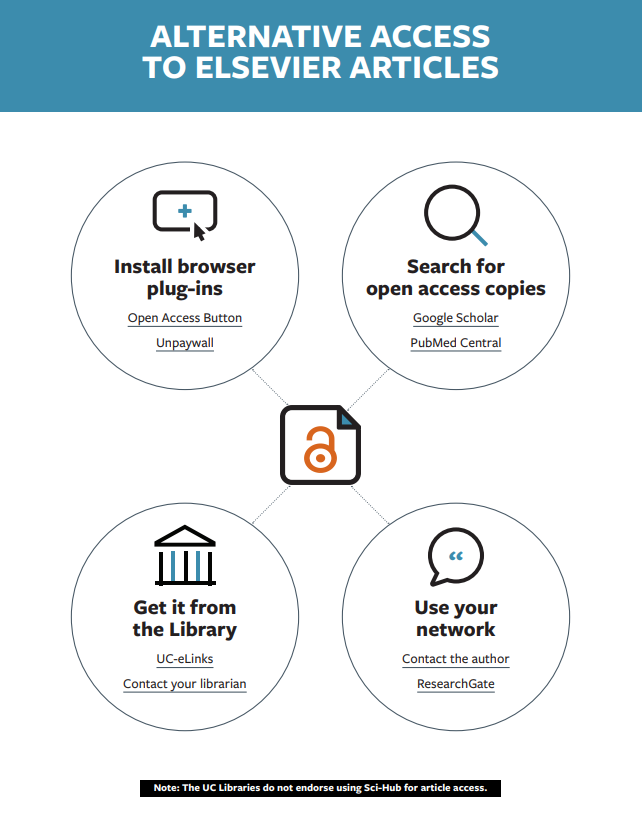
The facilitated collection
As a major research enterprise, UC Libraries invest heavily in bought and licensed materials, and will continue to do so. That said, this step suggests that the libraries will be facilitating access to a range of articles outside of the local licensed collection.
This UC guidance directs people away from the library website, and to resources that, in some cases, might once have been deprecated by the library. Of course, that these are plausible options promoted here is testament to the fact that they have become widely used, popular methods of access. So, the UC guidance underlines a shift that has already been taking place for some time as access to journal materials has diversified in a network environment.
More widely, academic libraries of all sizes are looking at such approaches, some more than others. This is driven by budget reasons, but also by local decisions around privileging open access or stepping away from various deals.
This is a confusing environment.
- The move to open access in various forms is advancing but without a single trajectory. There is a variety of national open access initiatives, different funder mandates, and variously developed institutional regimes. Materials will be made available open access in different ways (institutional repositories, publisher websites, subject repositories, …) and with different conditions attached.
- The licensing model, and the big deal, that have so characterized collection building activity in recent years, continue to be pressured and library organizations are responding in different ways. Single article purchase or ‘loan’ may become more common. Transition will involve an uneven mix of pay to publish and pay to read options.
- The routes by which research materials are available have diversified and new publishing models are emerging (megajournals, for example) as publishers position themselves in a changing context. The uneasy relationship between publishers and social research systems will evolve. The larger commercial publishers are extending the range of productivity, aggregation, and other product options they make available. Acquisitions by Elsevier in recent years are telling (Mendeley, Bepress, Pure, SSRN, Hivebench, 1Science, …).
- At the same time, there is growing interest for open access to other linked research artifacts - research data, methods, software – which further complicates the ecosystem.
- Access to the journal literature is fragmented in various ways, albeit with Google Scholar as a notable unifying funnel to a large part of the scholarly universe.
What this means is that the library view is shifting somewhat from management of a locally acquired collection to facilitating access to a broader range of scholarly resources. Here, the value relates to the ability to meet research and learning needs in the best ways available using a variety of resources, whether or not they are owned or licensed locally; and also to mobilizing library expertise in assisting faculty and students be effective in a complex information environment.
The facilitated collection becomes a more important part of what a library does in this diversified context.
The inside-out library collection
While this evolving environment creates some demand for advice in a changing environment, at the same time libraries are providing more services around the creation, curation and appropriate disclosure of institutional research outputs (preprints, research data, expertise profiles, and so on).
The UC advice notes eScholarship, the UC institutional repository as a source of articles.
This underlines the importance of the inside-out library as described above (see Mark Dahl and Aaron Tay on inside out library services). There is a natural connection between a focus on open access and a focus on the inside out library.
For example, in a striking characterization, Kristin Antelman and colleagues talk about “disinvesting from pseudo-stock (rented access to journals) while redirecting resources toward Caltech-contextualized stock (institutional bibliography) and open infrastructure.” Turner and Billings describe “flipping” their collections at UMass Amherst, through a twin focus on managing and disclosing unique institutional materials and on investing more in access to open content and infrastructure: “As the libraries developed the means of producing and providing open access to the University’s scholarship, teaching materials and special collections, it also dedicated financial and staff resources to OA resources, systems and organizations outside the University.”
And of course, what libraries make available in this way become in part what other libraries facilitate access to - especially as institutional materials find their way into institutional or subject repositories, are indexed by Google Scholar, are listed on faculty profiles, and so on.
Finally …
The UC action has galvanized attention. For Elsevier, the financial impact may be less of an issue than the potential loss of participation in their journals of UC authors, editors, and reviewers. This is because of the scale of the UC research enterprise. For faculty elsewhere, it is potentially important as an exemplary event – the example of UC authors may have more of an influence than the exhortation of their library. For other consortia and libraries it is a call to action.
It is certainly a strong signal that the scholarly ecosystem is really changing, and the surrounding discussion underlines some of those changes. We do not yet know what the new equilibrium will be.
In the interim, the facilitated collection and the inside-out library collection are gaining more attention as libraries think about collections as a service.
Thanks to MacKenzie Smith, University Librarian and Vice Provost, UC Davis, for commenting on a draft of this post.
Picture: I took the feature picture in the main library at UCLA.
Note: This post was cosmetically amended on 27 March 2021 to include feature picture and headings, and to adjust images. It was also very lightly edited for tense.

